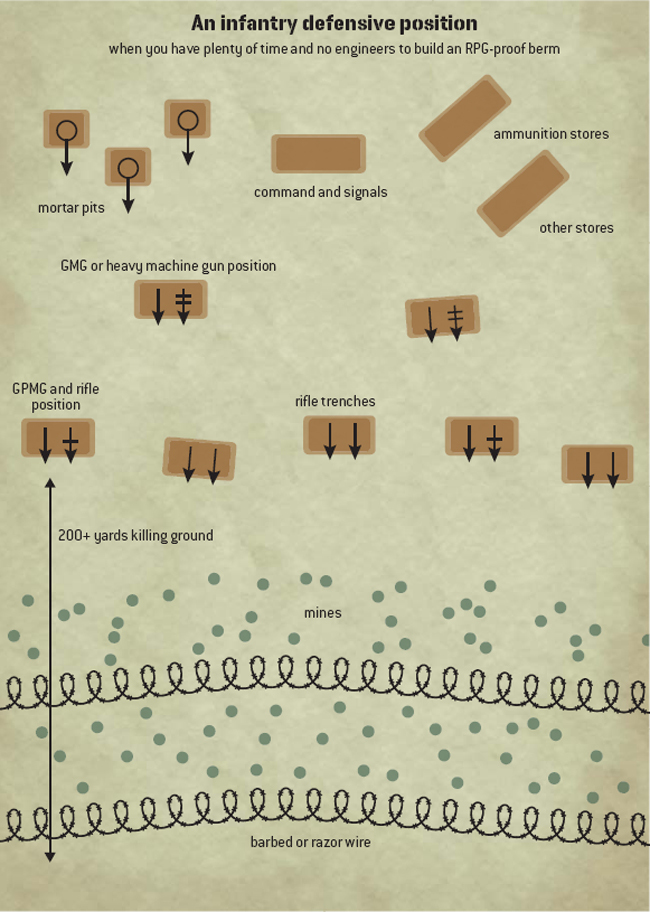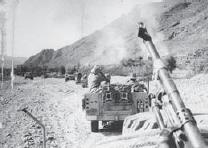If you can get the kit there are two other actions you can take: you can fire back accurately at the mortar launch point and you can shoot down the bombs in mid air. Yes, really!
Artillery Locating Radar
Since Vietnam there has been a radar system which picked up and tracked incoming mortar bombs, shells and ballistic missiles.
The radar takes a number of snap shots of where the projectile is in its flight path and calculates from these where it must have been fired from. Then it either prints out a grid reference for the firing point or in the later models it lays your artillery onto the firing point and takes out the people annoying you.
The Danes have developed a neat system called MAN 27.314 DFAEC ARTHUR which is mounted on a truck which you just park in your base. It spots any bombs or shells coming towards you and works out where they will land, where they have come from and lays your guns onto their firing position. It is efficient out to a range of about 40km or 25 miles and can handle eight targets at the same time and about 100 targets a minute. Which is pretty good I think. This system has worked well in Afghanistan for the British and other nations have their own variants. Of course you won’t get the use of this unless you are a big unit.
The skilled insurgent will fire a few mortar rounds and move to avoid the above response but just the threat of retaliation limits the time of attack and therefore the damage that can be done to you and your position.
Counter-Rocket, Artillery and Mortar (C-RAM)
Just in case you are timid and concerned about a few mortar rounds landing in your base before the counter-artillery radar wipes the firing party out, there is a novel protective system becoming available which uses a radar to spot and track incoming rockets, artillery shells and mortar bombs similar to the Artillery Locating Radar – then it lays on its own 20mm M61 Vulcan Gatling gun autocannon, and shoots them out of the air. I kid you not. It was developed by our friends in the US and called the Phalanx officially and R2D2 unofficially owing to its likeness to a Star Wars droid character. Don’t you just love it?
The British have had their own version, designed and built by the Dutch, which is deployed on all British warships of any size and is called Goalkeeper, as a football/soccer analogy. Similar in operation to the Phalanx it has a 30mm roller cannon and opens up with 70 rounds a second until the target is eliminated. This has been tested for air base defence but it is heavier than Phalanx and therefore not as portable.
Reconnaissance drones
Another defence option which will become more available as technology spreads its influence is a small reconnaissance drone which you can launch and use to monitor the opposition from above. They can even be fitted with heat detection and other clever stuff which I had better not mention here but which allows them to spot snipers, RPGs and mortars very easily in daylight or darkness. Happily for you, if the insurgent is in dead ground and leaving after firing his rounds the drone can still spot him. The drone will just transmit a grid reference to you or your artillery support and you can shell him to jelly before he has walked up a sweat.
Air assets
If a terrorist is foolish enough to maintain his position for a while then you can call in an airstrike. For those who have never experienced an efficient air-strike it is like you really got on the wrong side of God. There is no answer. The whole area is covered in cannon fire, shrapnel or napalm and it is difficult to do a ‘body count’ for the mush and bits lying around.
Snipers
But what about snipers in daylight when you don’t have any clever kit? You already know they are extremely difficult to spot. Probably the best you can do without special equipment is get the general direction from the thump of the rifle fire and gauge the rough distance by the time difference between the crack of the bullet passing overhead and the thump of the shot reaching you. For the hard of thinking, a rifle bullet travels faster than sound so it reaches you quicker than the sound from the rifle muzzle so you hear the ‘crack’ from the sonic boom before you hear the ‘thump’. The further apart these two sounds the further away the sniper. At ranges over a couple of hundred yards it starts to get noticeable and at long range very much so. A simple answer to an irritating sniper is to set up a dummy in an exposed position with a hollow body and some stiff card front and back. The idea is that when a sniper puts a bullet through the dummy you only have to look through the holes to see where it came from. Then you can use your own sniper, artillery or a rocket to take him out.
Response to a committed assault
The key point about defending against a properly organized assault is to maintain good command and control from a central position. By doing this you can ensure you know how the threat is developing and move your forces appropriately to strengthen the perimeter where it is under pressure or call in air strikes against specific threats.

You would be well aware if a classical attack was on the way as there would be a prelude including a thorough stonking by an artillery barrage to soften up your defence and organization. This will not happen in counter-insurgency as your artillery or air assets would destroy their artillery utterly in a few minutes and be glad of the chance.
What you might get in an insurgency operation is a surprise attack with the intention of quickly overrunning your position. This is how it might go: all of a sudden there is heavy incoming fire from machine guns and RPGs. Within moments a line of insurgents come racing across the open ground towards your position hoping to take advantage of you keeping your heads down.
It is up to you not to hide in the bottom of your trench but to return heavy, accurate fire. Your unit commander should be bringing fire to bear against the enemy suppressing fire and while he does that you need to stop the enemy closing with your defensive line.
If you are set up properly the assault group will be advancing over open ground, uphill across razor wire so they are not coming too quickly to shoot down. As they must be in the open to advance you can bring mortar or artillery fire to bear and pretty much any attack will be neutralized.
Does this sound too easy? Too simple? If it is easy, is it easy because you set up the position properly well before the attack kicked off. Your radios all worked well. You had your men in safe positions and your mortars in the middle of your base were ranged in on likely points of attack. Your wire was spread thickly across the killing ground and your guns covered it all. Train hard fight easy.
ANTI-AMBUSH DRILLS: PATROLS AND CONVOYS
A correctly executed ambush should be just that – execution. Everyone in the killing zone should be dead within 2 or 3 seconds. We will see in the next section how to set up an ambush properly and achieve that effect on the enemy, but here I want to go through the Standard Operating Procedures first of all to avoid being caught in an ambush and then for when you are ambushed yourself.
Given the ambush you are caught in is not set up properly then react correctly and you will have a good chance of survival – and you may even nail the ambushers. If the ambush is set up well then the SOPs give you something to think about for a few seconds...
Don’t get over excited about being ambushed; I have been ambushed scores of times and never has an ambush been set up or carried out properly. Obviously, as I am sat here rattling my gums.
